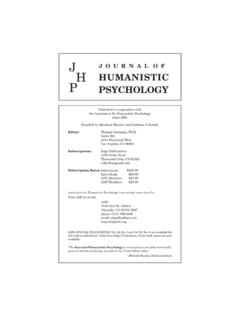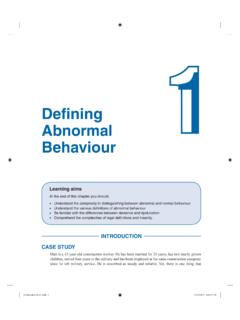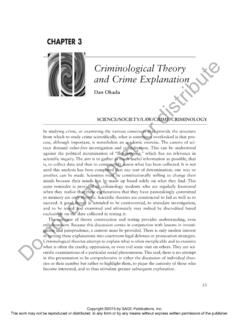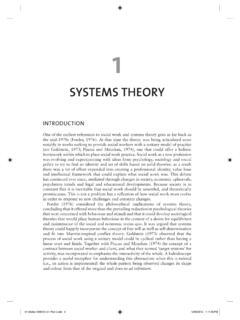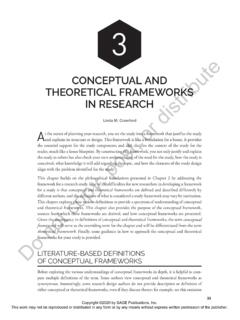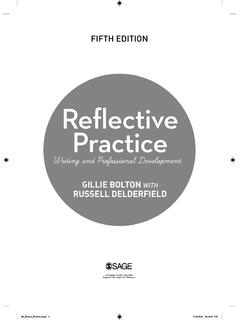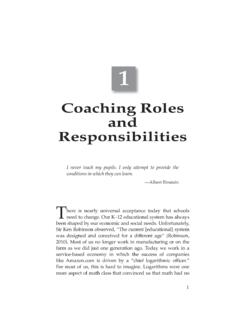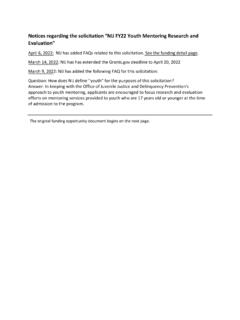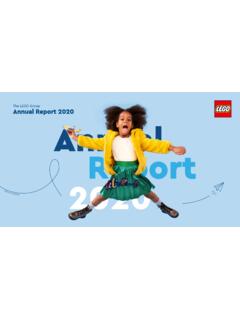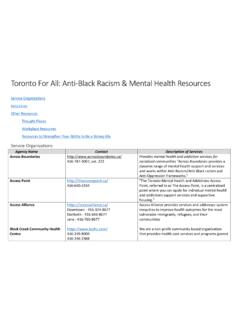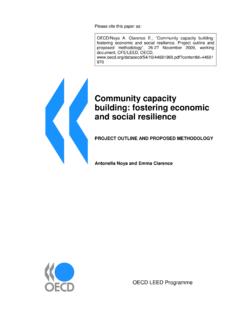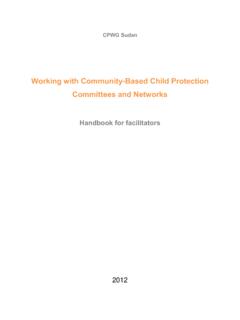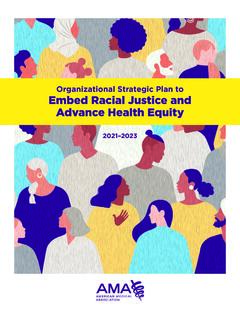Transcription of An Introduction to Child and Adolescent Mental Health
1 SAGE has been part of the global academic community since 1965, supporting high quality research and learning that transforms society and our understanding of individuals, groups and cultures. SAGE is the independent, innovative, natural home for authors, editors and societies who share our commitment and passion for the social out more at: Introduction to Child and Adolescent Mental Health Maddie Burton, Erica Pavord and Briony Williams00_Williams et 325-Mar-14 4:05:49 PM1 CHILDREN AND YOUNG PEOPLE S Mental Health MADDIE BURTONO verview Child and Adolescent Mental Health strategic view Child and Adolescent Mental Health context today Defining Child and Adolescent Mental Health Theoretical models Risk and resilience Mental Health conditions.
2 {Depression {Anxiety {Self-harm {Suicidal behaviour {Eating disorders {Early onset psychosis and substance misuse {Emerging personality disorder Neuro-developmental conditionsINTRODUCTIONThis chapter will provide an overview of Child and Adolescent Mental Health prob-lems and services. Psychological, biological, social and environmental theories inform our understanding of Mental Health problems. It is generally understood that a combination of nature and nurture theories, used to inform an understanding 01_Williams et 125-Mar-14 4:16:06 PMAN Introduction TO Child AND Adolescent Mental HEALTH2of human development, also offer the most likely theoretical explanations for understanding Child and Adolescent Mental Health .}}}}}}}
3 It is about the inter-play and inter-relation between: Biological factors (brain development and genetics); Psychological variables such as coping mechanisms; Genetic and physiological characteristics; Environmental circumstances (positive or negative). Another way of thinking about this is that an individual s inherent genes are trig-gered by experiences in childhood. Alternatively, positive experiences can mitigate or offset genetic factors. The nature and process of risk and resilience theory also requires exploration in order to understand the complex interplay between all these theoretical models. Child and Adolescent Mental Health encompasses a large area and it is difficult to fully explore them all within the confines of a chapter; so some areas have a larger focus here than AND Adolescent Mental Health : A STRATEGIC VIEWC hild and Adolescent Mental Health is a relatively new psychiatric healthcare special-ism; the Child and Adolescent Mental Health Services (CAMHS) we have today were commissioned and established following the Together We Stand Health Advisory Service Report (1995).
4 Prior to that date Child psychiatry was commonly situated in Child Guidance Clinics or Child Behaviour Clinics, with children being typically referred with symptoms such as larceny, masturbation and conduct disorder. Child Guidance Clinics were based on local commitment rather than explicit government policy. Young people with conditions including eating disorders and psychosis were treated in adult in-patient psychiatric hospitals and units. Since 2010 hospital mangers now have an obligation to provide age appropriate facilities (Barber et al., 2012). Current CAMHS provision as established in 1995 includes a tiered strategic service: Tier 1: a primary level of care; professionals include: GPs Health visitors School nurses Social workers Teachers Juvenile justice workers Voluntary agencies Social et 225-Mar-14 4:16:06 PMCHILDREN AND YOUNG PEOPLE S Mental HEALTH3 Tier 2: a service provided by professionals relating to workers in primary care.
5 Professionals include: Clinical Child psychologists Paediatricians (especially community ) Educational psychologists Child and Adolescent psychiatrists Child and Adolescent psychotherapists community nurses/nurse specialists Family 3: a specialised service for more severe, complex or persistent disorders; professionals include: Child and Adolescent psychiatrists Clinical Child psychologists Nurses ( community or in-patient) Child psychotherapists Occupational therapists Speech and language therapists Art, music and drama therapists Family 4: essential tertiary level services such as day units, highly specialised out-patient teams and in-patient units. All of the above Tier 3 professionals would be included in this AND Adolescent Mental Health TODAYMany Mental Health problems have origins in childhood (Dogra et al.)
6 , 2009). Half of lifetime Mental Health problems (excluding dementia) begin to emerge by age 14 and three-quarters by the mid-twenties (Department of Health , 2011a). The preva-lence of many childhood Mental Health disorders has increased in the western world during the last 25 years, particularly conduct disorders, anxiety and depression (Street et al., 2007). Ten per cent of five to fifteen year olds have a diagnosable Mental Health disorder. This suggests that around million children and young people under eighteen would benefit from specialist services. There are up to 45,000 young people with a severe Mental Health disorder. Around forty per cent of children with a Mental Health disorder are not currently receiving any specialist service.
7 (National Service Framework, 2004: Rationale )01_Williams et 325-Mar-14 4:16:06 PMAN Introduction TO Child AND Adolescent Mental HEALTH4 ActivityWhy do you think there is an increase in reports of Mental Health problems for children and young people in Britain today?There is a mixed picture of theories with no definitive answers! There is increased recognition and alertness to the possibility of Mental Health problems. Mental Health is now perhaps considered as an explanation and understanding of presenting behaviours. The Mental Health agenda is now much more publicised than previously, in part due to the media and to government Health awareness programmes. This has led to a more open discourse and together with all other Health issues information is now much more readily available via the internet.
8 Both parents and children are in some cases more likely to ask for help than in the past. Some Early Years settings professionals are now taking more interest in emotional and Mental Health . Chil-dren s centres which began with Sure Start in the last decade are paying more attention and recognising the significance of poor emotional and Mental Health in children, their carers and families. They have instigated active programmes and links with Health care professionals such as Health visitors and local Child and Adolescent Tier 2 and 3 services. The Healthy Child Programme: Pregnancy and the First Five Years of Life (Department of Health , 2009) has a strong emphasis and commitment to improving attachment quality between parents and children, a strong indicator of the now recognised importance of attachment and improved social and emotional wellbeing.
9 Early Years, teacher training programmes and social work training are rather slower in catching up with infant, Child and Adolescent Mental Health issues and understanding, as integral parts of their training. It is unfortunately at the moment patchy and in some areas non-existent. However the Health driven agenda has raised awareness in education settings with programmes such as the three-year Targeted Mental Health in Schools (TaMHS) from 2008 to 2011 (Chimat, 2012), although this was a trial in specific areas in the country and only covered the 5 13 age group. Other initiatives have included Social and Emotional Aspects of Learning (SEAL, 2010) and Personal, Social and Health Education (PSHE, 2011).
10 CONTEXT OF Child AND Adolescent Mental HEALTHS cience now evidences that infants are not too young to experience Mental Health problems. Those who have experienced significant maltreatment exhibit clinical symptoms of post-traumatic stress disorder (PTSD) (National Scientific Council on the Developing Child , 2004: 3). How these difficulties can be ameliorated does however offer hope for repair and will be discussed in Chapter ill Health is an interpretation of illness and the medicalisation of behav-iours considered to be beyond the norm. What we are often presented with is a set of 01_Williams et 425-Mar-14 4:16:06 PMCHILDREN AND YOUNG PEOPLE S Mental HEALTH5behaviours which could be seen to be acting out of the individual internal working model .
